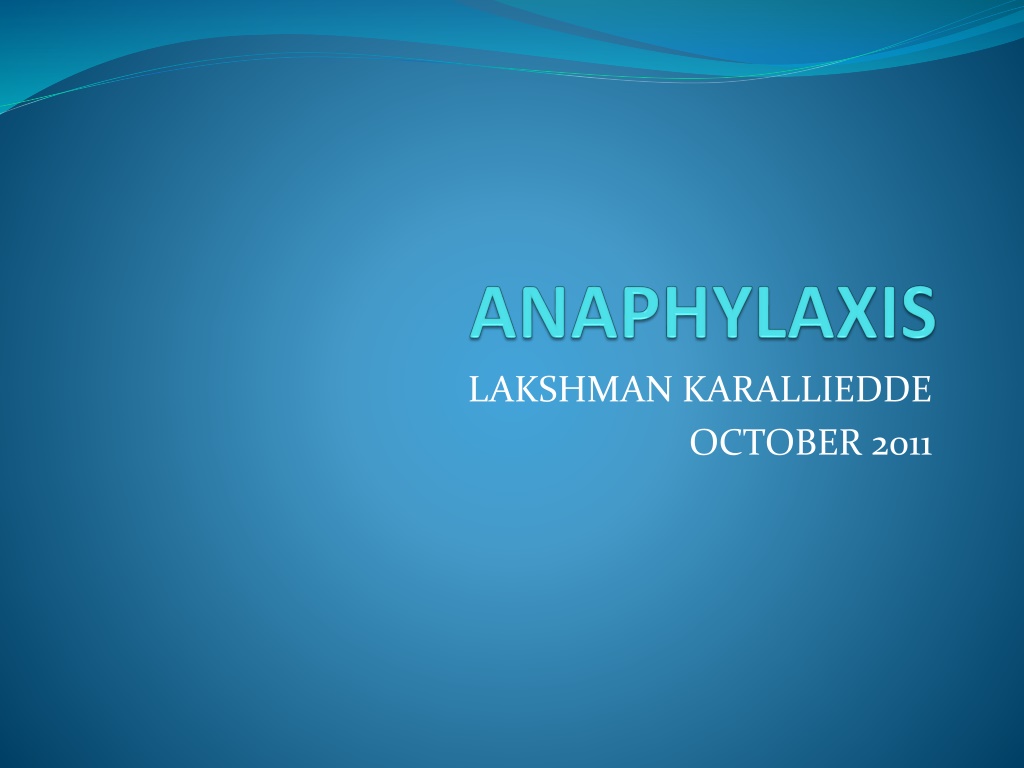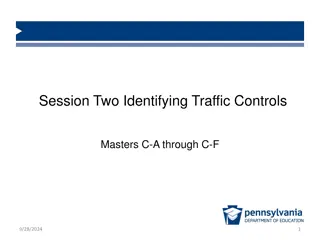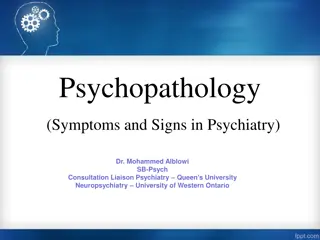Understanding Anaphylaxis: Symptoms, Signs, and Treatment
Anaphylaxis is a severe, life-threatening allergic reaction that can occur in response to various allergens. It manifests rapidly with symptoms like difficulty breathing, abdominal pain, skin reactions, and more. Early recognition of symptoms and prompt treatment with adrenaline are crucial for managing anaphylaxis effectively. Common triggers include food allergies, drug allergies, and insect bites. Knowing the signs and symptoms can help in timely intervention and improve outcomes for individuals experiencing anaphylaxis.
Download Presentation

Please find below an Image/Link to download the presentation.
The content on the website is provided AS IS for your information and personal use only. It may not be sold, licensed, or shared on other websites without obtaining consent from the author. Download presentation by click this link. If you encounter any issues during the download, it is possible that the publisher has removed the file from their server.
E N D
Presentation Transcript
LAKSHMAN KARALLIEDDE OCTOBER 2011
A precise definition of anaphylaxis is not important for the emergency treatment of an anaphylactic reaction. There is no universally agreed definition. The European Academy of Allergology and Clinical Immunology Nomenclature Committee proposed the following broad definition: Anaphylaxis is a severe, life-threatening, generalised or systemic hypersensitivity reaction. This is characterised by rapidly developing life-threatening airway and/or breathing and/or circulation problems usually associated with skin and mucosal changes.
ANAPHYLAXIS IS A LIFE-THREATENING TYPE OF ALLERGIC REACTION Can occur at any time. Risks include a history of any type of allergic reaction. Anaphylaxis is a severe, whole-body allergic reactionto a chemical that has become an allergen. INCIDENCE 1 million cases of venom anaphylaxis 0.4 million cases of nut anaphylaxis up to age 44 years worldwide. Approximately 20 anaphylaxis deaths reported each year in the UK (specific causes of anaphylaxis -prevalence and severity data available) PROGNOSIS Overall prognosis of anaphylaxis is good. Case fatality ratio of less than 1% reported in most population-based studies. Risk of death is, however, increased in those with pre-existing asthma, particularly if the asthma is poorly controlled or In asthmatics who fail to use, or delay treatment with adrenaline.
Anaphylaxis can occur in response to any allergen. Common causes include: Drug allergies Food allergies Insect bites/stings Pollens and other inhaled allergens rarely cause anaphylaxis. Some people have an anaphylactic reaction with no known cause.
SYMPTOMS A. DEVELOP RAPIDLY- OFTEN WITHIN SECONDS OR MINUTES. May include the following: Abdominal pain or cramping-Diarrhoea, Nausea, Vomiting Difficulty breathing- Abnormal (high-pitched) breathing sounds- Wheezing Cough Fainting, light-headedness, dizziness, Anxiety, Confusion, Slurred speech Difficulty swallowing Skin redness , Hives, itchiness Nasal congestion Palpitations
SIGNS Include: Abnormal heart rhythm (arrhythmia), Low blood pressure, Rapid pulse Wheezing, Fluid in the lungs (pulmonary edema) Hives, Skin that is blue from lack of oxygen or pale from shock Mental confusion Swelling (angioedema) in the throat that may be severe enough to block the airway Swelling of the eyes or face Weakness
LIFE-THREATENING PROBLEMS Airway: swelling, hoarseness, stridor Breathing: Rapid breathing Wheeze Fatigue Cyanosis, SpO2 < 92% Confusion A warning sign of dangerous throat swelling is a very hoarse or whispered voice, or coarse sounds when the person is breathing in air. Circulation: Pale clammy skin/extremeties Low blood pressure Faintness Drowsy/coma
EMERGENCY TREATMENT OF ANAPHYLACTIC REACTIONS- Resuscitation Council (UK) Establish airway High flow oxygen IV fluid challenge Chlorphenamine ((IM or slow IV) (IM or slow IV)- Adult or child more than 12 years 10 mg Child 6 - 12 years 5 mg Child 6 months to 6 years 2.5 mg Child less than 6 months 250 micrograms/kg 25 mg Hydrocortisone ((IM or slow IV) (IM or slow IV) Adult or child more than 12 years -200mg Child 6 - 12 years 100 mg Child 6 months to 6 years 50 mg Child less than 6 months 25 mg Monitor- Oxygen saturation- Pulse oximetry Blood Pressure ECG
Epidemiology One of the problems is that anaphylaxis is not always recognised. Further, the criteria for inclusion vary in different studies and countries. Incidence rate The American College of Allergy, Asthma and Immunology Epidemiology of Anaphylaxis Working group summary: overall frequency of episodes of anaphylaxis -between 30 and 950 cases per 100,000 persons per year. Lifetime prevalence between 50 and 2000 episodes per 100,000 persons or 0.05-2.0%. Lifetime age-standardised prevalence of a recorded diagnosis of anaphylaxis of 75.5 per 100,000 in 2005. Calculations based on these data indicate that approximately 1 in 1,333 of the English population have experienced anaphylaxis at some point in their lives
DO NOT: - Assume that any allergy shots the person has already received will provide complete protection. Place a pillow under the person's head if he or she is having trouble breathing. This can block the airways. Give the person anything by mouth if the person is having trouble breathing. Paramedics or physicians may place a tube through the nose or mouth into the airways (endotracheal intubation) or perform emergency surgery to place a tube directly into the trachea (tracheostomy or cricothyrotomy). DO : - 1. Take steps to prevent shock. 2. Have the person lie flat, raise the person's feet about 12 inches (Do NOT place the person in this position if a head, neck, back, or leg injury is suspected or if it causes discomfort. 3. Cover with coat or blanket.
Outlook (Prognosis) Anaphylaxis is a severe disorder that can be life-threatening without prompt treatment. However, symptoms usually get better with the right therapy, so it is important to act right away. Possible Complications Airway blockage Cardiac arrest (no effective heartbeat) Respiratory arrest (no breathing) Shock
TRIGGERS Anaphylaxis can be triggered by any of a very broad range of triggers. Those most commonly identified include Food Drugs Venom. Food - particularly important in children Medicinal products being much more common triggers in older people. Virtually any food or class of drug can be implicated, although the classes of foods and drugs responsible for the majority of reactions are well described. Of foods- nuts are the most common cause Drugs: muscle relaxants, antibiotics, NSAIDs and aspirin are most commonly implicated IN MANY CASES, NO CAUSE CAN BE IDENTIFIED. A significant number of cases of anaphylaxis are idiopathic (non-IgE mediated).
TRIGGERS II Stings 47 - 29 wasp, 4 bee, 14 unknown Nuts 32 -10 peanut, 6 walnut, 2 almond, 2 brazil, 1 hazel, 11 mixed or unknown Food 13 -5 milk, 2 fish, 2 chickpea, 2 crustacean, 1 banana,1 snail Food possible cause 17- 5 during meal, 3 milk, 3 nut, 1 each - fish, yeast, sherbet, nectarine, grape, strawberry Antibiotics 27- 11 penicillin, 12 cephalosporin, 2 amphotericin, 1 ciprofloxacin, 1 vancomycin Anaesthetic drugs 39- 19 suxamethonium, 7 vecuronium, 6 atracurium, 7 at induction Other drugs 24- 6 NSAID, 3 ACEI, 5 gelatins, 2 protamine, 2 vitamin K, 1 each - etoposide, acetazolamide, pethidine, local anaesthetic, diamorphine, streptokinase Contrast media 11- 9 iodinated, 1 technetium, 1 fluorescein Other 3- 1 latex, 1 hair dye, 1 hydatid
TIME COURSE FOR FATAL ANAPHYLACTIC REACTIONS When anaphylaxis is fatal, death usually occurs very soon after contact with the trigger. From a case-series, fatal food reactions cause respiratory arrest typically after 30 35 minutes Insect stings cause collapse from shock after 10 15 minutes Deaths caused by intravenous medication occur most commonly within five minutes. DEATH NEVER OCCURRED MORE THAN SIX HOURS AFTER CONTACT WITH THE TRIGGER
ANAPHYLAXIS IS LIKELY WHEN ALL OF THE FOLLOWING CRITERIA ARE MET: Sudden onset and rapid progression of symptoms Life-threatening Airway and/or Breathing and/or Circulation problems Skin and/or mucosal changes (flushing, urticaria, angioedema) The following supports the diagnosis: Exposure to a known allergen for the patient Remember: Skin or mucosal changes alone are not a sign of an anaphylactic reaction. Skin and mucosal changes can be subtle or absent in up to 20% of reactions (some patients can have only a decrease in blood pressure, i.e., a Circulation problem) There can also be gastrointestinal symptoms (e.g. vomiting, abdominal pain, incontinence)
SUDDEN ONSET AND RAPID PROGRESSION OF SYMPTOMS The patient will feel and look unwell. Most reactions occur over several minutes. Rarely, reactions may be slower in onset. The time of onset of an anaphylactic reaction depends on the type of trigger. An intravenous trigger will cause a more rapid onset of reaction than stings- which, in turn, tend to cause a more rapid onset than orally ingested triggers THE PATIENT IS USUALLY ANXIOUS AND CAN EXPERIENCE A SENSE OF IMPENDING DOOM
LIFE-THREATENING AIRWAY AND/OR BREATHING AND/OR CIRCULATION PROBLEMS Patients can have either an A or B or C problem or any combination. Use the ABCDE approach to recognise these. Airway problems: Airway swelling, e.g., throat and tongue swelling (pharyngeal/laryngeal oedema). The patient has difficulty in breathing and swallowing and feels that the throat is closing up. Hoarse voice. Stridor this is a high-pitched inspiratory noise caused by upper airway obstruction. Breathing problems: Shortness of breath increased respiratory rate. Wheeze. Patient becoming tired. Confusion caused by hypoxia. Cyanosis (appears blue) this is usually a late sign. Respiratory arrest. There is a range of presentation from anaphylaxis- anaphylaxis with predominantly asthmatic features- to a pure acute asthma attack with no other features of anaphylaxis. Life-threatening asthma with no features of anaphylaxis can be triggered by food allergy. Anaphylaxis can present as a primary respiratory arrest.
CIRCULATION PROBLEMS Signs of shock pale, clammy. Increased pulse rate (tachycardia). Low blood pressure (hypotension) feeling faint (dizziness), collapse. Decreased conscious level or loss of consciousness. Anaphylaxis can cause myocardial ischaemia and electrocardiograph (ECG) changes even in individuals with normal coronary arteries. Cardiac arrest. Circulation problems (referred to as anaphylactic shock) can be caused by direct myocardial depression, vasodilation and capillary leak, and loss of fluid from the circulation. Bradycardia (a slow pulse) is usually a late feature, often preceding cardiac arrest. The circulatory effects do not respond or respond only transiently to simple measures such as lying the patient down and raising the legs. Patients with anaphylaxis can deteriorate if made to sit up or stand up. A, B and C problems can all alter the patient s neurological status (Disability problems) because of decreased brain perfusion. There may be confusion, agitation and loss of consciousness. Patients can also have gastro-intestinal symptoms (abdominal pain, incontinence, vomiting).
SKIN AND/OR MUCOSAL CHANGES These should be assessed as part of the Exposure when using the ABCDE approach. THEY ARE OFTEN THE FIRST FEATURE AND PRESENT IN OVER 80% OF ANAPHYLACTIC REACTIONS. They can be subtle or dramatic (just skin, just mucosal, or both skin and mucosal changes). There may be erythema a patchy or generalised, red rash. There may be urticaria (also called hives, nettle rash, weals or welts), which can appear anywhere on the body. The weals may be pale, pink or red, and may look like nettle stings. They can be different shapes and sizes, and are often surrounded by a red flare. They are usually itchy.
Angioedema is similar to urticaria but involves swelling of deeper tissues, most commonly in the eyelids and lips, and sometimes in the mouth and throat. Although skin changes can be worrying or distressing for patients and those treating them, skin changes without life-threatening airway, breathing or circulation problems do not signify an anaphylactic reaction. Reassuringly, most patients who have skin changes caused by allergy do not go on to develop an anaphylactic reaction. Differential diagnosis Life-threatening conditions: Anaphylactic reaction can present with symptoms and signs that are very similar to life- threatening asthma this is commonest in children. A low blood pressure (or normal in children) with a petechial or purpuric rash can be a sign of septic shock. Seek help early if there are any doubts about the diagnosis and treatment. Following an ABCDE approach will help with treating the differential diagnoses.
Non life-threatening conditions (these usually respond to simple measures) Faint (vasovagal episode). Panic attack. Breath-holding episode in child. Idiopathic (non-allergic) urticaria or angioedema. There can be confusion between an anaphylactic reaction and a panic attack. Victims of previous anaphylaxis may be particularly prone to panic attacks if they think they have been re-exposed to the allergen that caused a previous problem. The sense of impending doom and breathlessness leading to hyperventilation are symptoms that resemble anaphylaxis in some ways. While there is no hypotension, pallor, wheeze, or urticarial rash or swelling, there may sometimes be flushing or blotchy skin associated with anxiety adding to the diagnostic difficulty. Vasovagal attacks after immunisation procedures-absence of rash, breathing difficulties, and swelling are useful distinguishing features, as is the slow pulse of a vasovagal attack compared with the rapid pulse of a severe anaphylactic episode. Fainting will usually respond to lying the patient down and raising the legs.
ADRENALINE (EPINEPHRINE) ADRENALINE IS THE MOST IMPORTANT DRUG FOR THE TREATMENT OF AN ANAPHYLACTIC REACTION. Consistent anecdotal evidence supporting its use to ease breathing difficulty and restore adequate cardiac output. As an alpha-receptor agonist, it reverses peripheral vasodilation and reduces oedema. Its beta-receptor activity dilates the bronchial airways, increases the force of myocardial contraction, and suppresses histamine and leukotriene release. There are also beta-2 adrenergic receptors on mast cells that inhibit activation, and so early adrenaline attenuates the severity of IgE-mediated allergic reactions. Adrenaline seems to work best when given early after the onset of the reaction but it is not without risk, particularly when given intravenously. Adverse effects are extremely rare with correct doses injected intramuscularly (IM). Sometimes there has been uncertainty about whether complications (e.g., myocardial ischaemia) have been caused by the allergen itself or by the adrenaline given to treat it.
Intramuscular (IM) Adrenaline The intramuscular (IM) route is best for most who have to give adrenaline to treat an anaphylactic reaction. Monitor the patient as soon as possible (pulse, blood pressure, ECG, pulse oximetry) -To monitor the response to adrenaline. Benefits of IM route : There is a greater margin of safety. It does not require intravenous access. The IM route is easier to learn. Best site for IM injection - anterolateral aspect of the middle third of the thigh. The subcutaneous or inhaled routes for adrenaline are not recommended because they are less effective Adrenaline IM dose adults 0.5 mg IM (= 500 micrograms = 0.5 mL of 1:1000) adrenaline Adrenaline IM dose children- scientific basis forrecommended doses is weak. > 12 years: 500 micrograms IM (0.5 mL) i.e. same as adult dose 300 micrograms (0.3 mL) if child is small or prepubertal > 6 12 years: 300 micrograms IM (0.3 mL) > 6 months 6 years: 150 micrograms IM (0.15 mL) < 6 months: 150 micrograms IM (0.15 mL) Repeat the IM adrenaline dose if there is no improvement .Further doses can be given at about 5-minute intervals according to the patient s response.























